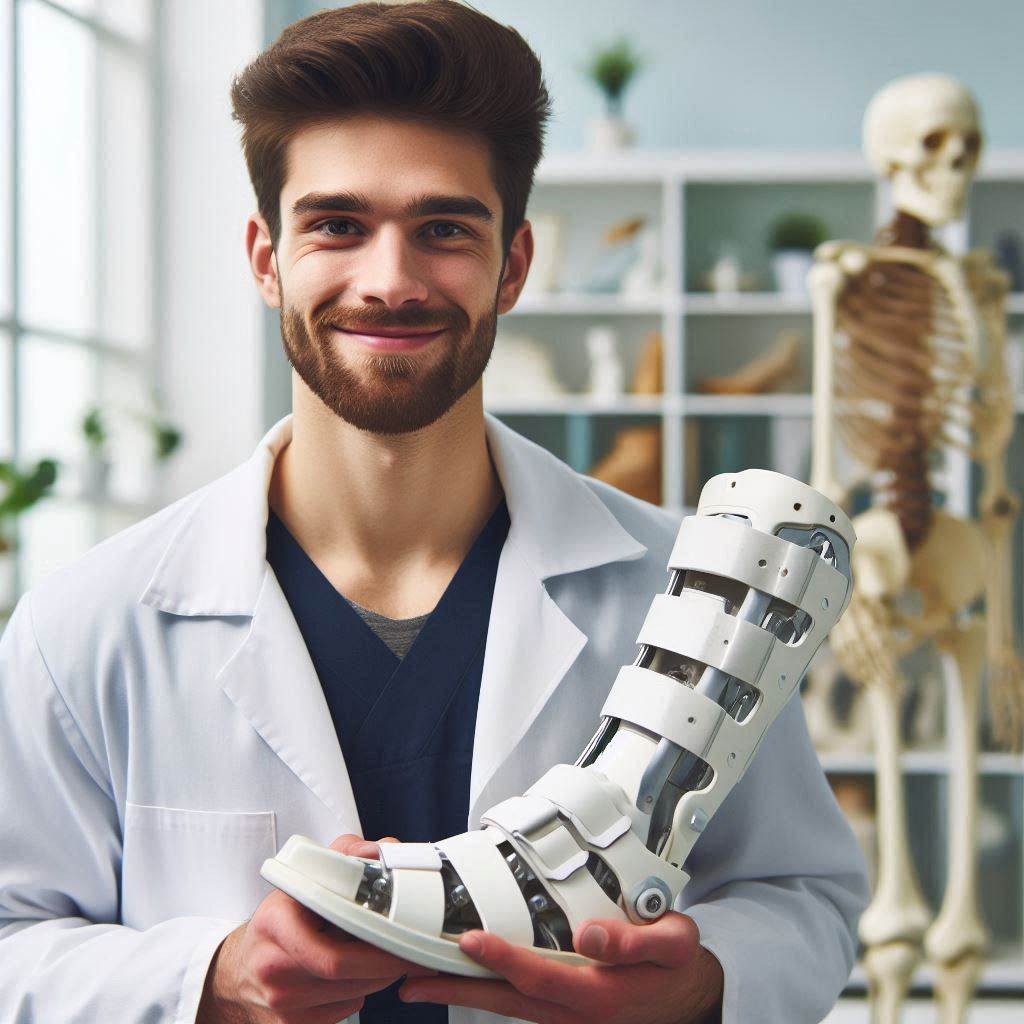Introduction
Orthotists and prosthetists both play crucial roles in healthcare, but their functions differ significantly.
Orthotists design, create, and fit orthoses, which are devices that support or correct musculoskeletal deformities and abnormalities.
These devices help patients improve mobility and manage pain.
Prosthetists, on the other hand, focus on designing, fabricating, and fitting prostheses, which are artificial limbs for individuals who have lost a limb due to injury, disease, or congenital conditions.
Understanding the key differences between orthotists and prosthetists is essential for patients and healthcare professionals alike.
Patients benefit by knowing which specialist to consult for their specific needs.
For instance, someone with scoliosis might need an orthotist, while an amputee would see a prosthetist.
Healthcare professionals can provide better referrals and collaborate more effectively with the appropriate specialist.
In summary, orthotists specialize in orthoses to support and correct body parts, while prosthetists create prostheses to replace missing limbs.
Recognizing these differences ensures that patients receive the most suitable care and support for their individual conditions.
Education and Training
Orthotists
- To become an orthotist, you need a bachelor’s degree in orthotics and prosthetics.
- You must also complete a clinical residency program to gain hands-on experience.
- Certification is required, which involves passing the Orthotics Certification Board exam.
- Licensure is necessary to practice as an orthotist in most states.
Prosthetists
- To become a prosthetist, you need a bachelor’s degree in orthotics and prosthetics.
- Completion of a clinical residency program is necessary to develop practical skills.
- Prosthetists must pass the Prosthetics Certification Board exam for certification.
- Like orthotists, prosthetists need to be licensed to work in most states.
Read: Orthotist/Prosthetist vs. Other Allied Health Professions
Scope of Practice
When comparing orthotists and prosthetists, one of the key differences lies in their scope of practice.
Orthotists
- Focus on designing, fitting, and customizing orthotic devices.
- Experts in creating braces, splints, and other orthopedic devices.
- Help patients with musculoskeletal issues improve mobility and function.
- Work closely with patients recovering from injuries or managing conditions.
Prosthetists
- Specialize in designing, fitting, and customizing prosthetic limbs.
- Create artificial limbs for amputees due to accidents, illnesses, or congenital disabilities.
- Focused on enhancing the quality of life and function for amputees.
- Help patients adjust to and use prosthetic devices effectively.
It is essential to understand the distinct roles of orthotists and prosthetists to appreciate the specialized care they provide to their patients.
Read: How to Become an Orthotist/Prosthetist: A Step-by-Step Guide
Collaborative Approach
Orthotists and prosthetists play a vital role in the overall well-being of patients by collaborating in their care.
Their combined expertise helps in creating holistic treatment plans that address the individual needs of each patient.
Importance of Collaboration
Orthotists and prosthetists often work together to ensure that patients receive the best possible care.
By combining their knowledge and skills, they can develop treatment plans that are tailored to the unique needs of each patient.
Collaborative Examples
One way orthotists and prosthetists collaborate is by sharing information about a patient’s condition and treatment goals.
By working together, they can ensure that the patient receives the most effective treatment possible.
Transform Your Career Today
Unlock a personalized career strategy that drives real results. Get tailored advice and a roadmap designed just for you.
Start NowAnother example of collaboration is when orthotists and prosthetists work together to design and fit custom orthotic or prosthetic devices for patients.
By pooling their expertise, they can create devices that are comfortable, functional, and meet the specific needs of the patient.
Complementary Expertise
Orthotists and prosthetists have different areas of expertise that complement each other in patient care.
Orthotists specialize in designing and fitting orthotic devices, such as braces and splints, to support and align parts of the body.
On the other hand, prosthetists focus on designing and fitting prosthetic devices, such as artificial limbs, to replace missing body parts.
By working together, orthotists and prosthetists can address a wide range of mobility and functional issues in patients.
In fact, the collaborative approach of orthotists and prosthetists is essential in providing comprehensive care for patients.
By working together, they can develop personalized treatment plans, design custom devices, and ensure that patients receive the best possible care for their unique needs.
Technical Skills
When it comes to technical skills, both orthotists and prosthetists require a unique set of expertise to excel in their respective fields.
Orthotists
Proficiency in biomechanics is crucial for orthotists as they need to understand how the body moves and functions to create orthotic devices that provide the right support and alignment.
Knowledge of materials is also essential as orthotists work with various types of materials to craft custom-made orthoses for their patients.
They need to have a deep understanding of how materials behave under different conditions and how to choose the most suitable ones for each individual’s needs.
Prosthetists
Prosthetists, on the other hand, require expertise in anatomy and physiology to design and fit prosthetic limbs that closely mimic the functions of missing body parts.
Understanding the structure and function of the human body is crucial for prosthetists as they need to create prostheses that are comfortable, functional, and natural-looking.
They must be able to analyze the biomechanics of movement and ensure that the prosthetic limb enables the patient to perform everyday tasks with ease and efficiency.
Overall, while both orthotists and prosthetists work in the field of orthotics and prosthetics, their technical skills differ significantly, with orthotists focusing more on biomechanics and materials, and prosthetists specializing in anatomy and physiology.
Read: What Does an Orthotist/Prosthetist Do? Career Overview

Patient Interaction
When it comes to patient interaction, orthotists and prosthetists have distinct roles and approaches in assessing and treating individuals.
Orthotists
Orthotists primarily focus on assessing the specific needs of their patients.
Showcase Your Business Today
Reach thousands of readers actively exploring professional services. Publish your business profile and grow your audience now.
Publish NowThey work closely with individuals to understand their mobility issues, physical limitations, and functional goals.
Orthotists are trained to measure and fit orthotic devices that provide support, correction, or protection for various parts of the body.
One of the key aspects of an orthotist’s job is to ensure that the orthotic devices are custom-made to suit the unique requirements of each patient.
This involves taking precise measurements, considering the patient’s comfort and mobility, and making adjustments as needed to achieve optimal functionality.
Furthermore, orthotists provide ongoing care and support to patients.
They monitor the effectiveness of the orthotic devices, make necessary adjustments, and educate patients on how to use and maintain their orthoses properly.
Orthotists play a crucial role in improving patients’ quality of life by enhancing their mobility and overall well-being.
Prosthetists
On the other hand, prosthetists specialize in helping patients regain mobility and independence through prosthetic limbs.
They work with individuals who have undergone limb amputations due to various reasons, such as accidents, congenital conditions, or medical complications.
Prosthetists focus on designing, fitting, and customizing prosthetic limbs that mimic the function and appearance of natural limbs.
They collaborate closely with patients to understand their goals and preferences, ensuring that the prosthetic devices meet their physical and aesthetic needs.
In addition to providing prosthetic devices, prosthetists offer comprehensive rehabilitation services to help patients adapt to their new limbs.
They guide individuals through the process of learning how to use the prosthetic devices effectively, regain mobility, and achieve independence in their daily activities.
Overall, both orthotists and prosthetists play crucial roles in enhancing the lives of patients with mobility impairments.
While orthotists focus on assessing patient needs, measuring for devices, and providing ongoing care, prosthetists emphasize helping individuals regain mobility and independence through prosthetic limbs.
Read: Top Public Health Administration Internships and Fellowships
Delve into the Subject: Common Conditions Managed by Telehealth Specialists
Career Opportunities
Orthotists and prosthetists play a crucial role in the healthcare industry, providing specialized care and devices to improve the quality of life for individuals with mobility impairments.
Both professions offer unique career opportunities with distinct job settings and growth potential.
In this section, we will explore the career prospects for orthotists and prosthetists, as well as the varied career paths available in the field of orthotics and prosthetics.
Orthotists
Job Settings
Orthotists work in a variety of settings, including hospitals, rehabilitation centers, orthopedic clinics, and specialty orthotic and prosthetic facilities.
They collaborate with physicians, physical therapists, and other healthcare professionals to design and fit orthotic devices for patients with musculoskeletal conditions or injuries.
Orthotists also provide ongoing care and adjustments to ensure the proper functioning of the orthotic devices.
Career Advancement Opportunities
Orthotists have opportunities for career growth through advanced certifications and specializations.
They can pursue additional training in specific areas of orthotics, such as pediatrics, sports medicine, or neurorehabilitation.
Experienced orthotists may also move into leadership roles, such as clinical supervisors or department managers, within healthcare organizations.
Prosthetists
Job Prospects
Prosthetists work with individuals who have undergone limb amputations to design, measure, and fit prosthetic limbs.
They work closely with patients to assess their needs and preferences, customize prosthetic devices, and provide training on how to use and care for the prostheses.
Prosthetists may work in hospitals, prosthetic clinics, rehabilitation centers, or government agencies that serve individuals with limb loss.
Growth Potential
The field of prosthetics offers promising growth potential due to advancements in technology, materials, and techniques.
Prosthetists can specialize in specific types of prosthetic devices, such as upper-limb prostheses or microprocessor-controlled prosthetics, to expand their expertise and career opportunities.
With a growing population of individuals in need of prosthetic services, prosthetists can expect a high demand for their skills and expertise.
Varied Career Paths
Individuals pursuing a career in orthotics and prosthetics have a range of career paths to choose from, based on their interests and goals.
Some orthotists and prosthetists work directly with patients, providing hands-on care and support.
Others may focus on research and development, designing innovative orthotic and prosthetic devices.
Additionally, some professionals choose to specialize in a particular patient population, such as pediatric orthotics or prosthetics for athletes.
Furthermore, orthotists and prosthetists can explore opportunities in academia, teaching future generations of healthcare professionals or contributing to research projects in the field.
Some may choose to start their practices or work in consulting roles to provide specialized services to patients in need of orthotic and prosthetic care.
With the diverse career paths available, individuals in the field of orthotics and prosthetics can tailor their careers to align with their interests and ambitions.
In a nutshell, orthotists and prosthetists have unique career opportunities that offer rewarding experiences and the chance to make a positive impact on the lives of individuals with mobility challenges.
Showcase Your Business Today
Reach thousands of readers actively exploring professional services. Publish your business profile and grow your audience now.
Publish NowWhether working in clinical settings, research and development, academia, or private practice, orthotists and prosthetists play a vital role in enhancing the independence, mobility, and overall well-being of their patients.
Conclusion
When it comes to orthotics and prosthetics, understanding the difference between orthotists and prosthetists is crucial.
Orthotists specialize in designing and fitting orthopedic braces to support or correct musculoskeletal issues.
They work closely with patients to assess their needs and provide custom orthotic devices tailored to individual requirements.
Prosthetists, on the other hand, focus on designing and fitting artificial limbs for individuals who have undergone limb amputations.
They ensure that prosthetic limbs are comfortable, functional, and enable patients to regain mobility and independence.
Overall, orthotists and prosthetists play distinct yet equally important roles in enhancing the quality of life for their patients.
Recap of the key differences between orthotists and prosthetists
- Orthotists focus on orthopedic braces, while prosthetists specialize in artificial limbs.
- Recognizing the distinct roles and contributions of each profession is essential in the healthcare industry.
- Individuals interested in orthotics or prosthetics are encouraged to explore these rewarding careers.
[E-Books for Sale]
The Big Book of 500 High-Paying Jobs in America: Unlock Your Earning Potential
$19.99 • 500 High-Paying Jobs • 330 pages
Explore 500 high-paying jobs in America and learn how to boost your career, earn more, and achieve success!
See All 500 High-Paying Jobs of this E-Book
1001 Professions Without a Degree: High-Paying American Jobs You Can Start Now
$19.99 • 1001 Professions Without a Degree • 174 pages
Discover 1001 high-paying jobs without a degree! Unlock career tips, skills, and success strategies for just $19.99!




